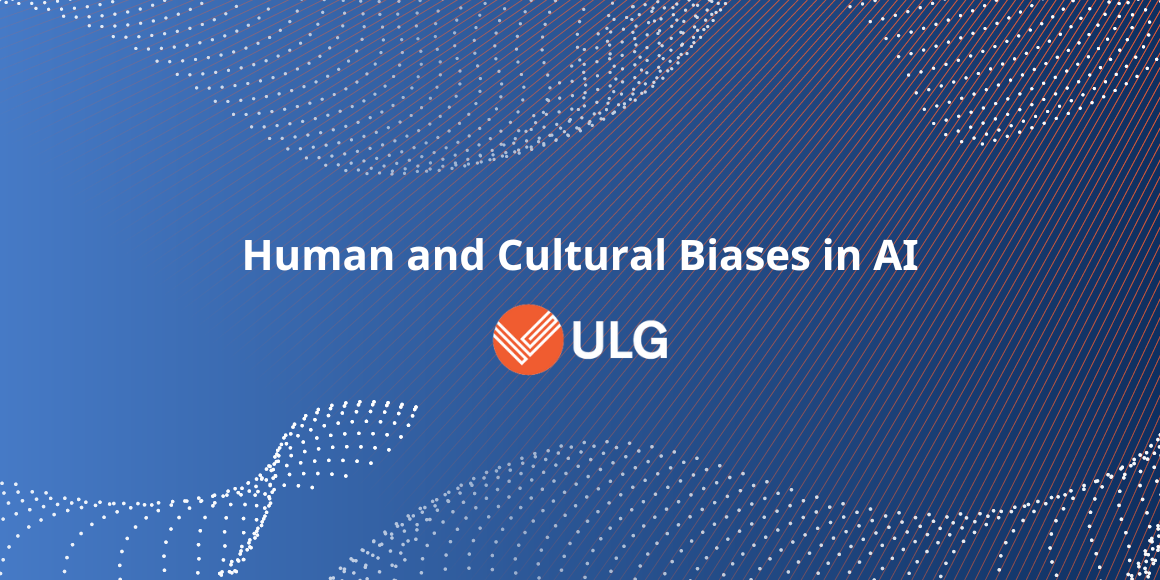Artificial Intelligence (AI) is everywhere you look, transforming the way we communicate and do business. Generative AI and large language models (LLMs) such as ChatGPT are grabbing headlines for their potential applications in many different industries. Combined with existing AI-powered machine translation (MT) technology, these innovative tools will increase speed and efficiency, allowing businesses to translate more content into more languages and channels more quickly than ever before.
This shift has the potential to benefit people and businesses in many ways. It can also reinforce existing inequalities and preconceived notions. AI is driven by technology but led by humans. It learns from data, and it absorbs biases. To use AI safely, businesses must understand and correct these tendencies. Our team shares here what we learned when we examined how cultural biases impact AI and machine translation, sometimes compromising translation accuracy while perpetuating stereotypes.
Artificial intelligence (AI) and machine translation
Machine translation has been AI-driven for some time. The technology is not new, but how we’re using it is changing rapidly. Neural machine translation (NMT) uses an artificial neural network to predict the translation of text. NMT is more accurate than the previous generation of statistical machine translation models. Generative AI and LLMs add new capabilities to machine translation technology, but they are not necessarily more accurate than existing solutions.
The influence of bias in AI and MT
Societal prejudice is a persistent problem for machine translation. Google Translate has struggled for the past decade with outdated gender stereotypes in its translations. Its algorithm was documented “chang[ing] the gender of translations when they do not fit with stereotypes” in just one of many examples. LLMs may stereotype emotions. People who are described as “anxious,” “depressed,” or “devastated” might be inaccurately referred to as feminine in a translation because the LLM falsely associates these emotions with femininity.
In addition to outdated gender norms, AI is also prone to cultural biases. Translations may align with a societal or country norm rather than taking cultures into consideration. In certain cultures, social hierarchy is extremely important, and this carries over into language, with different registers of formal and informal language that indicate everyone’s place on the ladder. What happens when you translate from a language like English, which has relatively few honorifics, into a language that has many different degrees of formality, such as Spanish? NMT engines default to the formal tone 60-70% of the time.
Machine translation output can also reflect damaging stereotypes. When a possible translation is ambiguous, NMT models may choose the more derogatory option if the subject of the sentence belongs to certain racial or cultural groups. Recently, AI was utilized to translate a sentence from Mandarin to English. The characters representing "proud" were translated to something similar to either "satisfied" or "arrogant," depending on the race of the person they were associated with in the text. This is the downside of utilizing AI and something that a human eye can check for when advocating for multicultural content that represents current inclusive language.
AI is a mirror that reflects the prejudices of our societies. Algorithms are the products of the people who built them (including their unconscious biases) and the data they are trained to utilize. When product development teams lack diversity, it becomes harder to spot and correct biased outcomes before the product goes live. Diverse teams offer different perspectives and help organizations resist the temptation of groupthink. When training data contains biases or does not adequately represent different languages and cultures, that will be reflected in the resulting AI output.
When AI systems reflect human bias
What happens when human bias or prejudice creeps into artificial intelligence? Consider Microsoft’s short-lived Twitter AI chatbot called Tay. It was designed to interact with and learn from other Twitter users, and that’s exactly what it did. Unfortunately, it took only sixteen hours before the bot began to post inflammatory and offensive tweets, and Microsoft had to shut it down.
Other consequences of biased AI are less sensational but more impactful: the reinforcement of unfair stereotypes have negative impacts on historically marginalized groups that will increase as AI algorithms grow in scope. As far as translation is concerned, inaccuracies from biased AI can damage consumer trust.
The future of AI and MT is up to us
Humans are both the source of the problem and the solution for bias in AI and MT. Here’s how we can address this issue at each step of the process:
- AI system designers can reduce bias in their products by hiring more diverse team members and seeking out diverse training data when it’s available.
- Translators can post-edit MT output to correct biased or inaccurate translations. This gives the benefits of machine translation—improved speed and efficiency—while still maintaining quality.
Organizations of all types can benefit from incorporating AI and MT into their localization process, but these new technologies must be used strategically. Our team has developed a methodology to determine which content is best suited to AI and NMT, and we’d be happy to help you evaluate your options.
ULG is currently focusing on NMT because its tools are often more accurate and reliable. We curate the MT engines we work with to further improve accuracy, and we combine MT with Octave, our Translation Management System (TMS), to translate your content with even more precision.
Our team currently uses AI and NMT in over 45% of our workflows, providing our clients with the best possible returns on their language access budget.
We can help you design a strategy that will guide you to success, contact us for a consultation today!

